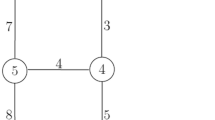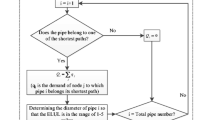Abstract
In the last two decades, water consumption in Germany has been decreasing, which causes the water tanks and pipes in water distribution systems to work inefficiently. This paper proposes a method that supports the planning process for tanks in water distribution systems. The method uses a combination of network reduction, mathematical optimization and hydraulic simulation. The mathematical optimization model is a non-convex Mixed Integer Quadratically Constrained Program (MIQCP) that is solved by a piecewise linearization. As this may lead to many binary variables and therefore high computing times, the size of the water distribution system model is reduced before building the optimization model. After applying several network reduction techniques and using a piecewise approximation of the original model, there may be some hydraulic differences between the original network model and the reduced network model. To make sure that the solution obtained in the optimization process is feasible in the original water distribution system model, the solution is verified by a hydraulic simulation. If the solution is not feasible, the reduced model has to be modified and solved again until the hydraulic simulation verifies a solution as feasible. In this paper, each of these processes is described and the results indicate the usefulness of each of them.





Similar content being viewed by others
References
Alperovits E, Shamir U (1977) Design of optimal water distribution systems. Water Resour Res 13(6):885–900
Ansary AE, Damatty AE, Nassef A (2010) A coupled finite element genetic algorithm technique for optimum design of steel conical tanks. Thin Walled Struct 48:260–273
Barakat SA, Altoubat S (2009) Application of evolutionary global optimization techniques in the design of RC water tanks. Eng Struct 31(2):332–344
Berthold T, Heinz S, Vigerske S (2012) Extending a CIP framework to solve MIQCPs. Springer, Berlin
Boulos PF, Lansey KE, Karney BW (2006) Comprehensive Water Distribution Systems Analysis Handbook for Engineers and Planners. MWH Soft
Burgschweiger J, Gnädig B, Steinbach MC (2005) Nonlinear programming techniques for operative planning in large drinking water networks. ZIB-Report 05-31, Konrad-Zuse-Zentrum für Informationstechnik Berlin
Cunha M, Ribeiro L (2004) Tabu search algorithms for water network optimization. Eur J Oper Res 157:746–758
Dandy G, Simpson A, Murphy L (1996) An improved genetic algorithm for pipe network optimization. Water Resour Res 32(2):449–458
Dantzig G (1966) Lineare Programmierung und Erweiterungen. Springer, Berlin
Djebeddjian B, Yaseen A, Rayan M (2006) Optimization of large-scale water distribution system design using genetic algorithms. In: Tenth international water technology conference, IWTC10 2006, pp 447–477
Dohle C, Suhl L (2012) An optimization model for the optimal usage of water tanks in water supply systems. In: Proceedings of the international conference on applied mathematical optimization and modelling APMOD 2012, pp 404–408
Eiger G, Shamir U, Ben-Tal A (1994) Optimal design of water distribution networks. Water Resour Res 30(9):2637–2646
Farmani R, Walters GA, Savic DA (2005) Trade-off between total cost and reliability for Anytown water distribution network. J Water Resour Plan Manag 131(3):161–171
Haehnlein C (2008) Numerische Modellierung zur Betriebsoptimierung von Wasserverteilnetzen. Dissertation, Technische Universität Darmstadt
Karger R, Cord-Landwehr K, Hoffmann F (2008) Wasserversorgung. Vieweg, Braunschweig
Kessler A, Shamir U (1989) Analysis of the linear programming gradient method for optimal design of water supply networks. Water Resour Res 25(7):1469–1480
Kurek W, Ostfeld A (2013) Multi-objective optimization of water quality, pumps operation, and storage sizing of water distribution systems. J Environ Manag 115:189–197
Lansey K, Mays L (1989) Optimization model for water distribution system design. J Hydraul Eng 115(10):1401–1418
Liong SY, Atiquzzaman M (2004) Optimal design of water distribution network using shuffled complex evolution. J Inst Eng 44(1):93–107
Mantell JB, Lasdon LS (1977) A GRG algorithm for econometric control problems. Ann Econ Social Meas 6(5):104–122
Maschler T, Savic D (1999) Simplification of water supply network models through linearisation. Report No 99/01, School of Engineering, University of Exeter
Nickel D, Lange MA, Ayres A, Schielein J, Oelmann M (2013) Ökologische und hygienische Kennzahlen im Benchmarking der Wasserversorgung: Empfehlungen aus Sicht des Gewässer- und Gesundheitsschutzes. Text 16/2013 des Umweltbundesamtes
Padberg M (2000) Approximating separable nonlinear functions via mixed zero–one programs. Oper Res Lett 27:1–5
Rautenberg J, Fritsch P, Hoch W, Merkl G, Otillinger F, Weiß M, Wricke B (2014) Mutschmann/Stimmelmayr Taschenbuch der Wasserversorgung. Vieweg, Braunschweig
Reehuis E (2010) Multiobjective robust optimization of water distribution networks. Internal Report 2010-04, Master Thesis, Leiden University
Rossman LA (2000) EPANET 2—Users Manual. Water Supply and Water Resources Division, National Risk Management Research Laboratory, Cincinnati
Simpson A, Dandy G, Murphy L (1994) Genetic algorithms compared to other techniques for pipe optimization. J Water Resour Plan Manag 120(4):423–443
Vamvakeridou-Lyroudia L (2007) Tank simulation for the optimization of water distribution networks. J Hydraul Eng 133(6):625–636
Acknowledgments
This work was partially supported by the German Research Foundation (DFG) within the Collaborative Research Centre On-The-Fly Computing (SFB 901).
Author information
Authors and Affiliations
Corresponding author
Rights and permissions
About this article
Cite this article
Hallmann, C., Suhl, L. Optimizing water tanks in water distribution systems by combining network reduction, mathematical optimization and hydraulic simulation. OR Spectrum 38, 577–595 (2016). https://doi.org/10.1007/s00291-015-0403-1
Received:
Accepted:
Published:
Issue Date:
DOI: https://doi.org/10.1007/s00291-015-0403-1




